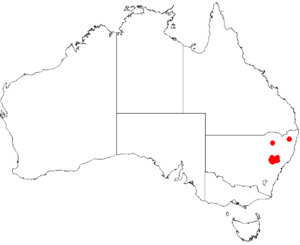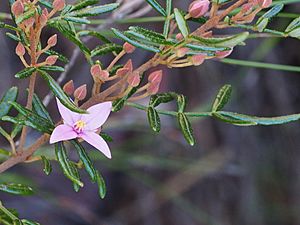Boronia angustisepala facts for kids
Quick facts for kids Boronia angustisepala |
|
|---|---|
 |
|
| Boronia angustisepala in the Gibraltar Range National Park | |
| Scientific classification | |
| Genus: |
Boronia
|
| Species: |
angustisepala
|
 |
|
| Occurrence data from Australasian Virtual Herbarium | |
The Boronia angustisepala is a beautiful plant that belongs to the citrus family called Rutaceae. It is special because it is endemic to New South Wales, Australia. This means it grows naturally only in that part of the world.
This plant is an upright shrub with many branches. Its leaves are pinnate, which means they have smaller leaflets arranged like a feather. Each leaf can have up to eleven leaflets. The Boronia angustisepala also has bright pink flowers, each with four petals.
Contents
What Does Boronia angustisepala Look Like?
This boronia is a shrub that stands upright and has many branches. It can grow up to about 1.5 m (5 ft) tall. Its younger branches are covered with tiny, star-shaped, and woolly hairs.
Leaves and Flowers
The leaves of Boronia angustisepala are pinnate, meaning they have several small leaflets. Each leaf can have between three and eleven leaflets. The whole leaf can be 10–55 mm (0.4–2 in) long and 3–30 mm (0.1–1 in) wide. The stem that connects the leaf to the branch, called a petiole, is about 2–5 mm (0.08–0.2 in) long.
The flowers are a bright pink color. You can often find up to three flowers growing together where the leaves meet the stem. Each flower sits on a small stalk called a pedicel, which is about 7–12 mm (0.28–0.47 in) long.
Flower Parts
Each flower has four sepals, which are like small, leaf-like structures that protect the flower bud. These sepals are narrow and can be 3–6 mm (0.12–0.24 in) long. They are hairy on their underside. The four bright pink petals are larger, about 9–12 mm (0.35–0.47 in) long. They get a little bigger as the fruit starts to grow.
Inside the flower, there are eight stamens, which are the parts that produce pollen. These stamens are different lengths. The plant usually flowers from July to November. After flowering, it produces small fruits, about 6 mm (0.24 in) long, with the dried petals still attached.
How Was This Plant Named?
The Boronia angustisepala was officially described in 1999 by a scientist named Marco F. Duretto. He published his description in a science journal called Muelleria. The first plant specimen used for this description was found in the Gibraltar Range National Park.
The second part of its scientific name, angustisepala, comes from two Latin words. Angustus means "narrow," and sepala refers to the "sepal." So, the name describes the plant's narrow sepals.
Where Does Boronia angustisepala Grow?
This type of boronia plant grows in forests. It prefers areas where the soil is made from sandstone or granite. You can find it in the Gibraltar Range National Park. It also grows in a few other areas in New South Wales, including the Bylong, Sandy Hollow, and Denman regions.



